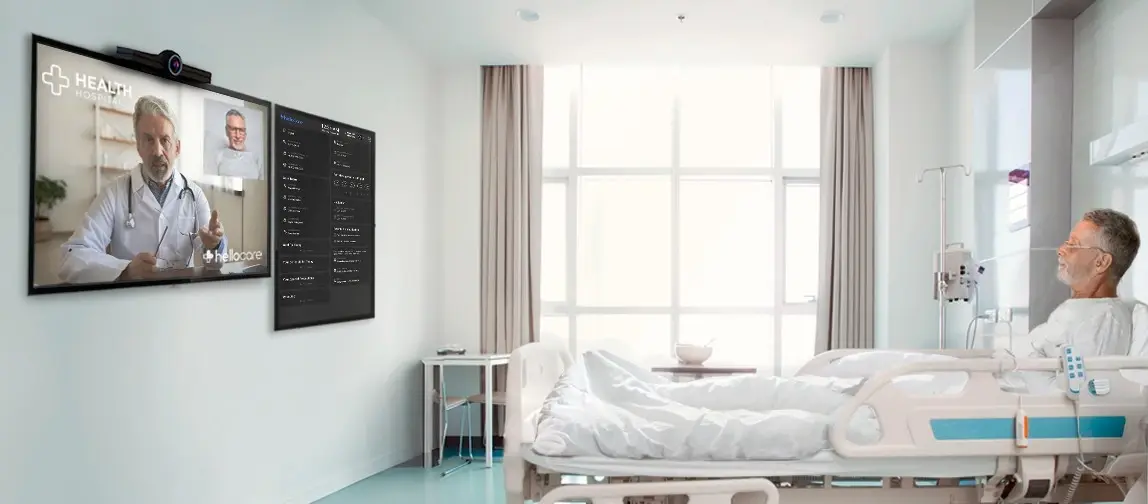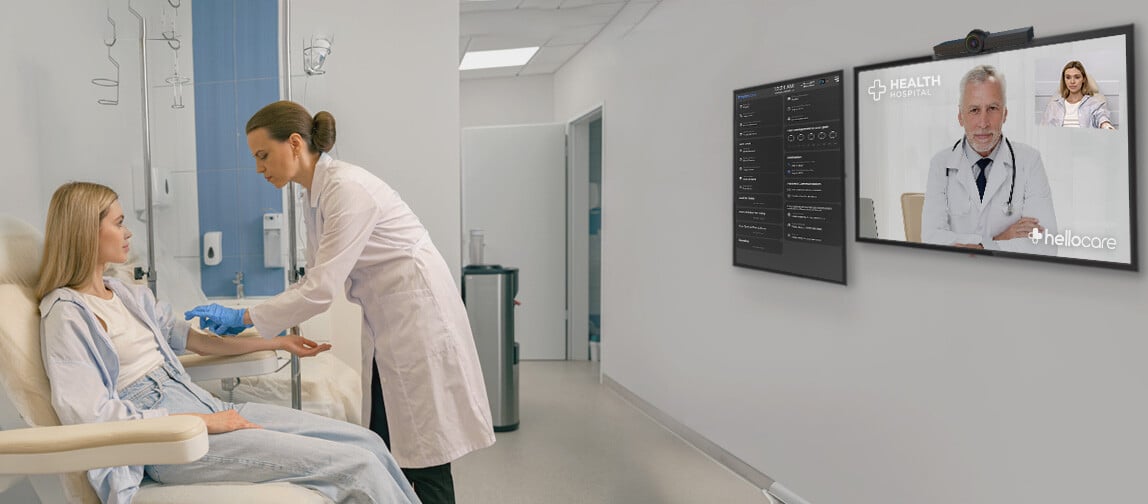Redefining Healthcare
What Does a Virtual Nurse Actually Do?
May 09, 2024 3:15:29 PM
.webp)
In the intricate tapestry of modern healthcare, a new thread is being woven, vibrant and increasingly
essential.
This thread is the virtual nurse, a role that has emerged not out of technological whimsy but as a
direct response
to a deepening crisis in healthcare staffing and a paradigm shift in how care is delivered. To
understand the essence
of this role, it's crucial to unravel the layers and examine what a virtual nurse truly does, especially
in the face of
daunting statistics and a changing healthcare landscape.
The departure of more than 100,000 nurses from the U.S. workforce between 2020 and 2021 is a stark reminder of the fragility of our healthcare system. Burnout, job dissatisfaction, family obligations, and COVID-19-related illness have eroded the ranks of nurses. The turnover for registered nurses (RNs) surged by about 8% in 2021, standing alarmingly at approximately 27%. Even more concerning is the projection by the American Nurses Association of a potential shortage reaching up to 1.13 million additional nurses by 2028. This exodus and the looming shortage paint a picture of a profession under siege, a system at its breaking point. Against this backdrop, the virtual nurse emerges as a beacon of resilience and adaptation.
Virtual nurses perform a variety of crucial tasks that significantly impact patient care and healthcare
management.
Their roles are diverse, ranging from patient education to direct involvement in clinical processes, all
facilitated
through advanced digital platforms.
Virtual nurses significantly enhance patient education by utilizing digital tools to provide clear,
accessible
information tailored to individual patient needs. This includes interactive tutorials, videos, and
digital brochures that
explain medical conditions, treatment plans, and steps for recovery in a way that patients can easily
understand and follow.
This mode of education allows patients to access information at their convenience, ensuring they are
well-informed about their
health status and treatment options, which can lead to better patient outcomes and higher satisfaction.
In staff mentoring, virtual nurses leverage their expertise to provide guidance and support to less
experienced
nursing staff, offering insights and knowledge that span basic care techniques to complex clinical
decisions.
This mentoring is crucial in hospitals with a wide geographic spread or in remote areas, where in-person
training
may be limited. Through virtual meetings, webinars, and real-time consultations, virtual nurses help
maintain a consistent
standard of care across multiple locations, enhancing the overall competency of the nursing staff.
Virtual nurses play a critical role in monitoring patient safety by utilizing data from electronic
health records
and real-time monitoring systems. They track vital signs, medication adherence, and recovery progress,
which helps
in early detection of potential complications. This continuous surveillance ensures that any deviation
from expected
recovery paths is addressed promptly, thereby maintaining high standards of patient care and safety.
Virtual rounding is a process where virtual nurses assist physicians and other medical staff in making
their rounds
via digital platforms. This can involve preparing patient summaries, highlighting critical issues that
need attention,
and facilitating real-time communication between the patient and the physician. Virtual rounding allows
for more frequent
and flexible interactions with patients, enhancing the responsiveness and effectiveness of the care
provided.
Virtual nurses streamline the admissions and discharge processes by ensuring that all necessary medical
information
is accurately recorded and communicated. They help manage paperwork digitally, schedule follow-up
appointments, and
ensure that discharge instructions are clear and comprehensive. This role is vital in preventing
readmissions and ensuring
that patients receive the necessary support as they transition from hospital care to home care.
By managing various administrative and educational tasks, virtual nurses enable bedside nurses to
concentrate more
on direct patient care. This redistribution of responsibilities enhances the overall quality of care by
allowing bedside
nurses to provide more personalized attention to patients. Virtual nurses support this by handling
routine inquiries,
updating patient records, and ensuring that all necessary information is available to the care team.
.webp) Virtual nurses are not just administrative aids; they are integral to the healthcare team, providing
critical support
that enhances the quality of care. They allow for a more efficient allocation of resources, ensuring
that bedside nurses
can devote more time to urgent, hands-on care. This support is vital in a system where the demand for
healthcare services
often outstrips the available human resources.
Virtual nursing addresses several modern healthcare challenges by restoring balance to nurse workloads
and filling care
gaps in the healthcare system. Virtual nurses act as a stabilizing force within hospitals, ensuring
continuous patient
monitoring and support, which is crucial for maintaining high standards of care and patient safety.
Virtual nurses are not just administrative aids; they are integral to the healthcare team, providing
critical support
that enhances the quality of care. They allow for a more efficient allocation of resources, ensuring
that bedside nurses
can devote more time to urgent, hands-on care. This support is vital in a system where the demand for
healthcare services
often outstrips the available human resources.
Virtual nursing addresses several modern healthcare challenges by restoring balance to nurse workloads
and filling care
gaps in the healthcare system. Virtual nurses act as a stabilizing force within hospitals, ensuring
continuous patient
monitoring and support, which is crucial for maintaining high standards of care and patient safety.
The departure of more than 100,000 nurses from the U.S. workforce between 2020 and 2021 is a stark reminder of the fragility of our healthcare system. Burnout, job dissatisfaction, family obligations, and COVID-19-related illness have eroded the ranks of nurses. The turnover for registered nurses (RNs) surged by about 8% in 2021, standing alarmingly at approximately 27%. Even more concerning is the projection by the American Nurses Association of a potential shortage reaching up to 1.13 million additional nurses by 2028. This exodus and the looming shortage paint a picture of a profession under siege, a system at its breaking point. Against this backdrop, the virtual nurse emerges as a beacon of resilience and adaptation.
Core Functions of a Virtual Nurse
1. Detailed Patient Education
2. Staff Mentoring
3. Patient Safety Surveillance
4. Physician Rounding Assistance
5. Admissions and Discharge Coordination
6. Holistic Patient Support
.webp)
Impact on Healthcare Quality and Efficiency
Navigating Modern Healthcare Challenges
The Future of Virtual Nursing
As healthcare continues to evolve, the role of virtual nurses is set to
expand.
They are a testament to the adaptability and resilience of the nursing profession, embodying a
patient-centered approach
that is crucial for the future of healthcare. Virtual nursing is more than a stopgap measure; it is
a sustainable model that
enhances the capacity of healthcare systems to meet the needs of their patients and staff
effectively.
The integration of virtual nursing into healthcare strategies represents a significant shift towards more dynamic and responsive healthcare delivery. This role not only addresses immediate staffing needs but also sets the stage for future innovations in how care is provided. As technology continues to advance, the capabilities and impact of virtual nurses will likely grow, further solidifying their role as essential components of modern healthcare.
The integration of virtual nursing into healthcare strategies represents a significant shift towards more dynamic and responsive healthcare delivery. This role not only addresses immediate staffing needs but also sets the stage for future innovations in how care is provided. As technology continues to advance, the capabilities and impact of virtual nurses will likely grow, further solidifying their role as essential components of modern healthcare.
Key points
- This innovative approach leverages technology to bridge physical and digital realms, creating a dynamic and personalized healthcare encounter.
- Effective communication and shared decision-making help prevent medical errors, reduce adverse events, and improve overall patient safety.
- Research indicates that patients who have positive experiences tend to be more engaged in their care, leading to better adherence to treatment plans and improved health outcomes.
- Virtual patient experience is here: Combines telemedicine, remote monitoring, and digital tools for personalized care.
93.4%
admissions completed by virtual nurses
admissions completed by virtual nurses
87.7%
discharges completed by virtual nurses
discharges completed by virtual nurses
350%
increase in bedside RN time spent administering medications
increase in bedside RN time spent administering medications
350%
increase in bedside RN time spent administering medications
increase in bedside RN time spent administering medications
Share
Article
Care to know more?
Request a demo to be informed about
the latest virtual nursing news and telehealth...
Related posts


